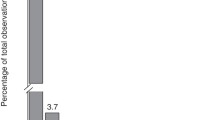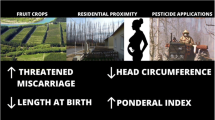Abstract
Introduction
The risk of adverse reproductive outcomes related to pesticide exposure has been investigated in few studies; however, the results have not been consistent. The goal of the present study was to evaluate the influence of maternal residual exposure to pesticides on birth weight among women in an agricultural district in Central Poland.
Method
Subjects included 104 women who delivered a single, live infant between 1 January 1994 and 31 December 2000. Based on maternal reports, the type of farming (crops, orchards, non-farming jobs), involvement in field work and the trade names of pesticides used within last pregnancy were established. Birth weight for the most recent pregnancy was abstracted from the medical data of the local maternity unit.
Results
Mothers who reported involvement in field work had a similar pregnancy duration but delivered infants with a significantly higher birth weight than mothers not reporting such activities in the first or secondtrimester of pregnancy (P=0.04). However, after controlling for pregnancy duration and other factors affecting birth weight, we found that maternal exposure to synthetic pyrethroids in the first or second trimester was associated with a small but statistically significant decrease in birth weight (P=0.02).
Conclusions
We postulate that the observed effect of pyrethroids exposure was related to a slower pace of foetal development corresponding to the small-for-gestational-age (SGA) birth.
Similar content being viewed by others
References
Arbuckle TE, Lin Z, Mery LS (2001) An explanatory analysis of the effect of pesticide exposure on the risk of spontaneous abortion in an Ontario farm population. Environ Health Perspect 109:851–857
Aue WW, et al. (1999) Cytogenetic effects from exposure to mixed pesticides and the influence from genetic susceptibility. Environ Health Perspect 107:501–505
Blair A, Zahm SH (1992) Patterns of pesticide use among farmers: implications for epidemiological research. Epidemiology 4:55–62
Cooper S, et al. (2001) Prenatal exposure to pesticides: a feasibility study among migrant and seasonal farmworkers. Am J Ind Med 40:578–585
Curtis KM, Savitz DA, Weinberg CR, Arbuckle TE (1999) The effect of pesticide exposure on time to pregnancy. Epidemiology 10:103–105
Dabrowski S, Hanke W, Polanska K, Makowiec-Dabrowska T, Sobala W (2003) Pesticide exposure and birthweight: an epidemiological study in Central Poland. Int J Occup Med Environ Health 16:31–39
de Cock J, Westveer K, Heederick D, te Velde E, van Kooij R (1995) Time to pregnancy and occupational exposure to pesticides in fruit growers in The Netherlands. Occup Environ Med 52:429–430
Fuortes L, Clark MK, Kirchner HL, Smith EM (1997) Association between female infertility and agriculture work history. Am J Ind Med 31:445–451
Garcia AM (1998) Occupational exposure to pesticides and congenital malformations: a review of mechanisms, methods, and results. Am J Ind Med 33:232–240
Hanke W. Kalinka J, Makowiec-Dabrowska T, Sobala W (1999) Heavy physical work during pregnancy—a risk factor for small-for-gestational-age babies in Poland. Am J Ind Med 36:200–205
Herandez-Valero M, Bondy M, Spitz MR, Zahn SH (2001) Evaluation of Mexican American migrant farmworker work practices and organochlorine pesticide metabolites. Am J Ind Med 40:554–560
Kristensen P (1999) Pesticides and reproduction. Epidemiology 10:103–104
Kristensen P, et al. (1996) Cancer in offspring of parents engaged in agricultural activities in Norway: incidence and risk factors in the farm environment. Int J Cancer 65:39–50
Kristensen P, et al. (1997) Gestational age, birth weight, and perinatal death among births to Norwegian farmers. Am J Epidemiol 146:329–338
Nurminen T (1995) Maternal pesticide exposure and pregnancy outcome. J Occup Environ Med 37:935–940
Padungtod C, Lasley BI, Christiani DC, Ryan LM, Xu X (1998) Reproductive hormone profile among pesticide factory workers. J Occup Environ Med 40:1038–1047
Pesticide Action Network Pesticide Database (http://www.pesticideinfo.org)
Petrelli G, et al. (2000) Reproductive male-mediated risk: spontaneous abortion among wives of pesticide applicators. Eur J Epidemiol 16:391–393
Rastrepo M, Munoz N, Day NE, Parra JE, de Romero L, Nguyen-Dinh X (1990) Prevalence of adverse reproductive outcomes in a population occupationally exposed to pesticides in Colombia. Scand J Work Environ Health 16:232
Rose R, et al. (1999) Pesticides. In: Marquardt H, Schafer SG, McClellan R, Welsch F(eds) Toxicology Academic Press, San Diego London Boston New York Sydney Tokyo Toronto, pp 663–697
San Jose S, Roman E, Beral V (1991) Low birthweight and preterm delivery, Scotland, 1981–84: effect of parents' occupation. Lancet 338:428–431
Savitz D. Whelan E, Kleckner RC (1989) Self-reported exposure to pesticides and radiation related to pregnancy outcome—results from National Natality and Fetal Mortality Surveys. Public Health Rep 104:473–477
Savitz D, Arbuckle T, Kaczor D, Curtis KM (1997) Male exposure and pregnancy outcome. Am J Epidemiol 146:1025–1036
Szamotulska K, Stankiewicz N (2000) Masa urodzeniowa, czas trwania ciąży i rozwój wewnątrzmaciczny nowordków oraz umieralność niemowląt i umieralność okołoporodowa noworodków w Polsce u progu nowego tysiąclecia. Instytut Matki i Dziecka. Zakład Epidemiologii Warszawa
Tordoir WF, Maroni M, He F (eds) (1994) Health surveillance of pesticide workers. A manual for occupational health professionals. Elsevier
Zhang J, Cai W, Lee DJ (1992) Occupational hazards and pregnancy outcomes. Am J Ind Med 21:397–408
Acknowledgements
This research was funded by the National Institute for Environmental Health Sciences through the University of Iowa Environmental Health Sciences Research Center, NIEHS/NIH P30 ES05605" and by the Nofer Institute of Occupational Medicine (Research Project IMP. 10.9, "Exposure to pesticides in orchard farmers and pregnancy outcome").
Author information
Authors and Affiliations
Corresponding author
Rights and permissions
About this article
Cite this article
Hanke, W., Romitti, P., Fuortes, L. et al. The use of pesticides in a Polish rural population and its effect on birth weight. Int Arch Occup Environ Health 76, 614–620 (2003). https://doi.org/10.1007/s00420-003-0471-4
Received:
Accepted:
Published:
Issue Date:
DOI: https://doi.org/10.1007/s00420-003-0471-4




